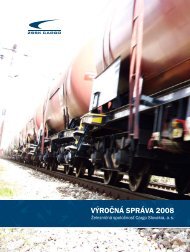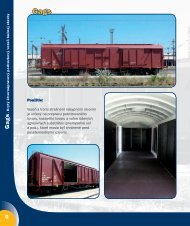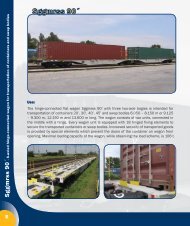CARGO BUSINESS 2-10.indd - ZSSK Cargo
CARGO BUSINESS 2-10.indd - ZSSK Cargo
CARGO BUSINESS 2-10.indd - ZSSK Cargo
- No tags were found...
You also want an ePaper? Increase the reach of your titles
YUMPU automatically turns print PDFs into web optimized ePapers that Google loves.
Prvý špecializovaný vozeň na prepravu kvapalín z roku 1858(obrázok prevzatý z knihy Kol.: A 125 éves MÁV. MÁV Budapest1993).First specialized wagon for transport of liquids from 1858 (phototaken from the book Kol.: A 125 éves MÁV. MÁV Budapest 1993)Cisterna s kotlom pripevneným ku spodku opaskami. Rok výroby1901.Cistern with a boiler fixed onto the bottom with belts. Year ofproduction 1901.Cisterna pre dopravu minerálnych olejov pre bratislavskú rafinériuAPOLLO z roku 1902.Cistern for transport of mineral oils for Bratislava refiner APOLLOfrom 1902.Súprava dvojkotlových cisterien krátko po ich vyrobení roku 1929.Set of double-boiler cisterns soon after their production in 1929.Charakteristická cisterna z 80. rokov 19. storočia.Characteristic cistern from the 80´s of the 19th century.múzejných zbierkachTwo and three-axled cistern wagonsFor a relatively long time after it started its operation, railroad didnot even seriously consider an option to transport the liquids. Atthat time, the only specialized vehicles were water cisterns of steamlocomotives. The Austrian company of the state railways (StEG)became the pioneer in the territory of Austro-Hungary Empire. Thiscompany constructed its first wagon, designed to transport liquids(in this case unrefined mineral oil) already in 1858. It was a smalltwo-axled wagon with loading capacity of 3 500 kg, which carrieda square container with straight walls. A similar wagon for a loadingcapacity of 8500 kg was built in 1860.However, the important natural resources for the chemical industryonly became available to the rail traffic after creation of rail network ofthe Austro-Hungary Empire in the 60´s and 70´s of the 19th centuryand thereby, its development was motivated. This development wasnecessary to create the suitable conditions for bulk transport of liquidsof all kinds - from tar acids, acids through a variety of oil products towine and cognac. At that time it was discovered that straight walls ofwagon cisterns for transportation of liquids were not optimal and thatcylindrical container would be a much better solution. The first suchwagon in the Empire appeared in 1870. Its vessel had a shape similarto the boiler and therefore it was given a name characteristic until thefirst half of the 20th century - boiler wagon.The real boom of cisterns, however, occurred at the turn of the 80´sand 90´s of the 19th century. Therefore, in 1890, the Austrian andHungarian railways adopted a Convention governing their constructionand operation. This convention included several principles, such asprinciple of maximum axle load (10 t) and wheelbase (up to 4.5 m)and minimum loading capacity for light and heavy liquids (10 and 15t), prohibiting the use of wooden blocks and riveting the boiler onto thebottom (in case of any problems, it had to be possible to dismantlethe boiler easily) and determining the arrangement for filling andemptying valves.In the exhibition of ŽSR (Railways of the Slovak Republic) companymuseum, this type of wagon is represented by a cistern fortransportation of liquid oil products with a density of 0.78 - 0.98kg/l, made in 1902 in wagon works Weitzer János Gépgyár Arad. Thewagon bottom is typical for the period of the turn of the 19th and 20thcentury. Cylindrical metal container with a capacity of 170 hl hasriveted structure with double-line riveting. On its back, in the middleof the boiler length, there is a filling dome with an opening. In thedome cover, the venting nozzle is installed. Discharge valve systemis formed by a valve in the centre of the boiler; its control spindle andwheel are located under the dome cover. Under the valve, in the centreof the boiler, the lateral piping is located, distributing the dischargedliquid on both sides of the wagon. On both sides, the lateral piping hasa cock and thread necessary for hose connection. In order to enablethe operating personnel to get to the dome, the wagon has stairs,railing and platforms on both sides. The cistern is fixed onto the wagonframe by longitudinal angles, riveted onto the boiler.Another type of a boiler placed on the bottom, characteristic for thatperiod, is represented by the cistern manufactured in Královopolskástrojírna in Brno in 1901. Boiler is placed onto four saddle crosspiecesof the bottom, onto which it is pushed by four flat circumferentialbelts. It is secured against movement in the longitudinal direction byflat strips, riveted onto the centre of the boiler. This wagon is now inPrievidza, where it serves to transport water for journeys of a steamlocomotive 464.001.Another interesting wagon is a cistern wagon from 1929. It has twoseparate boilers and it is designed to transport small quantities ofdifferent types of mineral oils to a single customer. One of only eightwagons made then can be currently found in the exposition of theformer depot Bratislava východ.In the 30´s of the 20th century, welding became a more significantmodernization method of construction of cistern wagons. Weldingmade the construction of wagons easier and enabled the extension ofrange of transported goods by chlorine.Development process of two-axled cistern wagons was completedby wagons with the so-called single bottom, designed in the CentralDesign Office of the national corporation Tatra and manufactured inenterprises Vagónka Tatra, n.p., Studénka and Královopolská strojírna,n.p., Brno between 1948 and 1967. This type of wagon is representedin the Slovak museum collections by a non-renovated wagon fortransport of sulphuric acid from 1960 with a boiler capacity of 125 hl,corresponding to a loading capacity of 20 t. It is interesting that thiswagon is equipped with steam heating pipes, which allows heating upthe solidified contents of the container prior to discharge.Jiří KUBÁČEKMuseum-documentation centre of ŽSRPhotos – archive of the Museum-documentation centre of ŽSR40/41
















